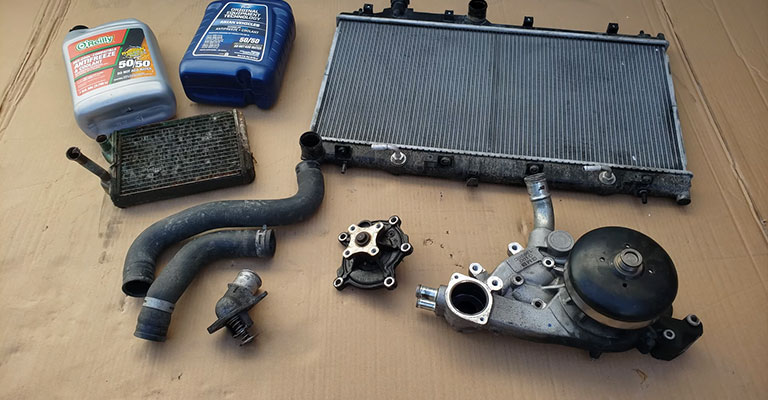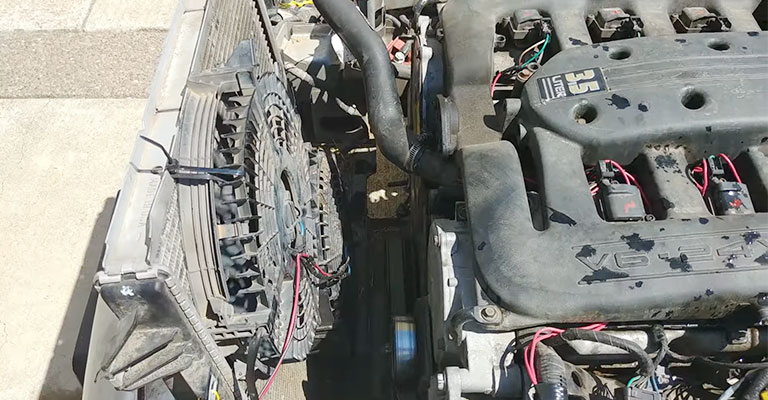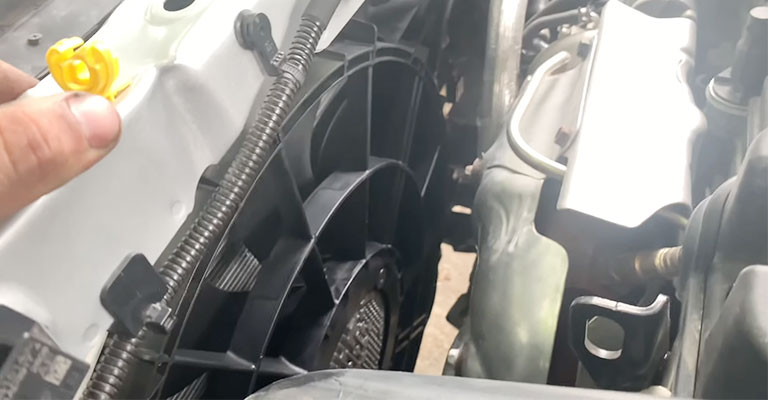The operation of an internal combustion engine generates a significant amount of heat. As a result, the car engine cools down in two ways when running in normal circumstances.
Antifreeze, also known as coolant fluid, is the first way. The purpose of this fluid is to maintain the engine’s temperature to prevent it from overheating. As well as preventing corrosion, it prevents scales from forming in the engine.
Secondly, oil flowing through the engine helps cool it down. In addition to serving as a lubricant, this oil is another coolant for hot engine components.
You should never worry about your car’s engine overheating as long as enough coolant and oil flow is in it. However, your engine can be seriously damaged by overheating.
Whenever your vehicle overheats, you should immediately stop driving it and start troubleshooting and repairing the problem. A car that is overheating can result in catastrophic consequences if you continue to drive it.
That being said, it is necessary to understand a cooling system’s operation before troubleshooting it.

Overheating Of Engines: Why Does It Happen?
There are many reasons why engines can overheat. A malfunction in the cooling system causes heat to build up in the engine compartment, which causes it to overheat. There are several possible causes, such as leaks in the cooling system, damaged radiator fans, clogged water pumps, or faulty water pumps.
Coolant is propelled throughout the engine block and head by the water pump. Upon reaching a predetermined temperature, relays trigger your thermostat to activate radiator fans, which regulate circulation and temperature.
Engine control units (ECUs) monitor the temperature through a temperature sensor. No matter where the problem originates, you don’t want to let an overheating engine linger. It is possible for your engine to suffer serious, if not permanent, damage as a result.
The Causes Of Car Overheating And How To Diagnose Them
Overheating is usually caused by a faulty pressure cap, so check this first. Gaskets on caps can deteriorate over time, allowing pressure to escape, and resulting in cooling system problems.
It’s easy to check the condition of your cap at most service stations. However, the cooling system isn’t always the cause of overheating problems. The following conditions can also cause overheating:
1. Make Sure The Thermostat Is Working

Overheating is not usually caused by a stuck thermostat. Thermostats that fail will either stick open or close. Coolant won’t circulate properly if it becomes stuck closed. Remove the water neck the radiator hose attaches to and drain the coolant to check the thermostat.
You’ll need boiling water to test a thermostat. First, boil some water and remove the thermostat. After a few minutes, remove the thermostat from the boiling water. When you remove it from the water, it should be open, then slowly close as it cools.
2. Keep An Eye Out For Leaks
The first thing you’d notice if there were a major leak would be that. Unfortunately, leaks of any size can be difficult to detect due to their small sizes, and they do not always result in a puddle.
A leak not only allows coolant to escape but also lets air in. There are times when the leak is so small that it only leaks when the engine is at operating temperatures due to heat causing expansion. Keep an eye out for coolant in your hoses.
3. Oil Is Low

Very few cases of this occur, but it can certainly happen! This is because the cooling property of oil is one of its most important properties. When there is not enough oil in the engine, friction will result, causing everything to become hotter.
Overheating can occur if the engine gets too hot. Make sure your oil level is adequate if your engine is overheating.
4. Take A Look At The Serpentine Belt
Check to see if the serpentine belt is still attached. In some cases, these belts break while driving, leaving little trace of their existence.
Pulleys without a belt can be found under the hood of your vehicle. In addition to turning your alternator, the serpentine belt drives your water pump.
It causes the coolant not to circulate if the belt breaks, causing the water pump not to turn. Overheating will result extremely quickly if this happens.
5. The Pressure Of The Cooling System Is Low

Several factors can cause a coolant that doesn’t build pressure. For example, if your radiator cap is busted or your water pump leaks, there is a problem. The engine will overheat regardless of coolant pressure.
6. Check The Fan Motor’s Performance
A problem with the electric motor that turns the fan or the relay that turns the fan on would cause the fans not to spin normally. There is a good chance that one of the motors will be at fault after testing it.
Expose the two metal pins inside the electrical connector by unplugging it. Then, connect one of these electrical pins to the positive battery terminal while wearing gloves. Run the other wire from the negative battery terminal to the other pin. Make sure the fan is spinning.
7. Spinning The Radiator Fans Is A Good Sign

As the vehicle approaches operating temperature, please turn it on and wait. It is essential to turn off all climate control systems. When the thermostat is set to defrost or the heating is on, it may bypass the relay trigger, which is why this procedure is being performed.
8. Ensure That The System Is Free Of Air
If air bubbles are present in the system, it can prevent the coolant from circulating efficiently. A spill-proof funnel and coolant are required for this procedure.
Air bubbles will rise up and out of the radiator when the funnel is connected to the vehicle, and the engine is running.
Your funnel will come with various attachments for attaching to your radiator. Make sure you use the funnel according to the instructions provided with it.
9. Maintain An Adequate Level Of Coolant And Check The Radiator Cap
Remove it from a completely cool, level surface by pressing down while turning counterclockwise on the radiator cap. The radiator should be filled with coolant up to the top. Top off the coolant if it is low. Radiators will struggle to cool sufficiently if the coolant level is low.
10. A Damaged Water Pump

Throughout the engine, the coolant is pushed by your vehicle’s water pump. You can’t get the most out of your coolant if it’s sitting stagnant. Depending on your car model, a broken water pump is one of the rarer problems.
Overheating Your Engine: What To Do?
Taking care of an overheated car as soon as possible is crucial. The car can shut down if you don’t resolve this issue eventually. Therefore, it might be a good idea to attempt these steps before you figure out what caused your car to overheat.
- Kill The A/C And Crank The Heat
Reduce the engine’s stress by turning off the air conditioner immediately. Once you have reached maximum heat, turn the dial.
During overheating, you can use this technique to pull heat away from the engine, preventing it from overheating. The discomfort may not be much, but it’s worth it compared to major engine repairs.
- Pull Over In A Safe Place
Stop the car and turn it off. Let the engine cool for a minimum of 15 minutes. Watch the temperature gauge as the engine cools, as it’ll return to normal after a while.
Prepare a plan to inspect your overheated engine while you wait (and watch the gauge). For assistance, contact a friend, a tow truck, or your local roadside assistance.
- Add Coolant To The System
You can prevent overheating if the coolant level in your engine is low by topping it off quickly. When your radiator fan or water pump is broken, or your coolant hose is clogged, this step won’t help much. For information regarding how to add coolant to your vehicle, consult your owner’s manual.
- Restart The Engine
You can restart your car carefully and drive to your nearest auto shop if it’s not being towed. While you’re driving, keep an eye on the temperature gauge. You’ll have to pull over and let it cool if it rises again.
When Your Engine Overheats, What Should You Not Do?
If you drive with an overheating engine, you may end up stranded on the side of the road and have to pay for a tow truck.
- It’s Not Worth Letting The Issue Linger
Adding some coolant won’t solve an overheating engine on its own. Leaving it unaddressed will only make it worse. To help save your engine, find the cause of the problem.
- Don’t Panic
Keeping your engine cool isn’t easy, but you can do it! Don’t swerve through traffic or slam on the brakes if you are pulling off the road.
- It’s Not A Good Idea To Open The Hood Right Away
If you want to check things out under the hood, wait for the engine to cool before popping the hood. You can be burnt or injured if you open the hood immediately after it has spewed steam or smoke.
Therefore, it is important to be patient. The hood should not be opened until the engine’s temperature gauge has settled.
- Don’t Keep Driving
Overheating engines shouldn’t keep running and staying on the road won’t help them. You may damage your engine significantly (and at considerable expense) by pushing your engine too far.
Conclusion
Maintain your car, and it will maintain you. It is important to flush and exchange your car’s coolant regularly to prevent overheating. Be sure to follow the manufacturer’s recommendations for radiator maintenance as well.
By regularly examining your radiator and engine, you will be able to resolve any potential problems before they become worse. Don’t drive farther if your vehicle is overheating.
Instead, put the vehicle in park, turn it off, and pull over. Some steps can be taken to assess any problem but towing the car to the nearest repair shop is the best option.

Leave a Reply